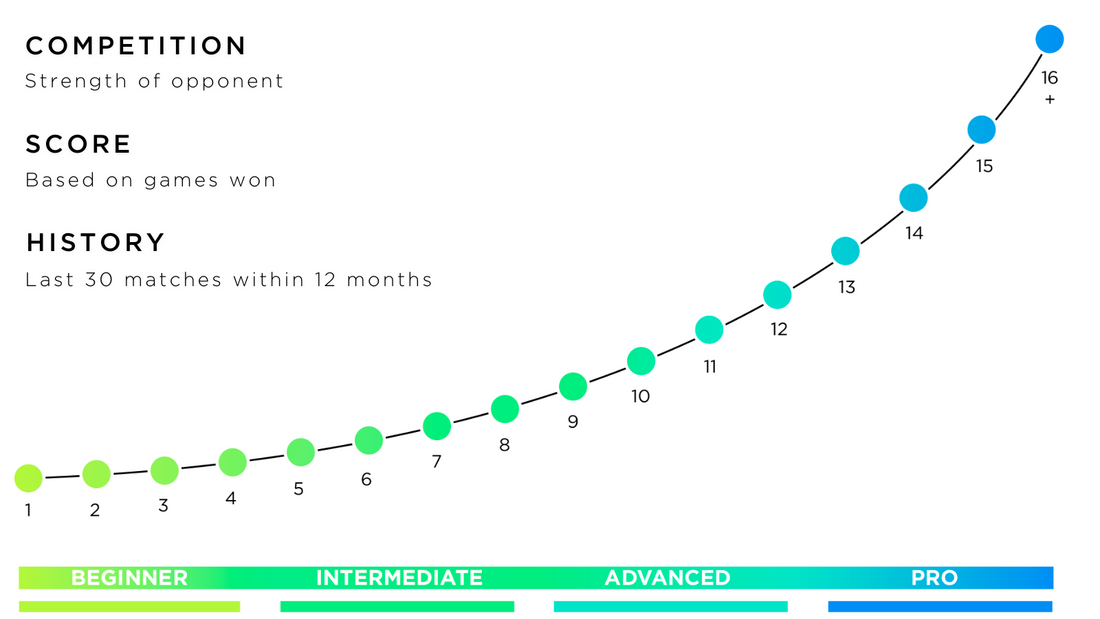Your guide to how the UTR Rating algorithm works.
The UTR Rating, also known as the Universal Tennis Rating, was created by UTR Sports (formerly known as Universal Tennis) as a global rating system that promotes fair and competitive play across the tennis world.
It's more just than a ranking system. All players, regardless of age, gender, geography, or skill level, are rated on the same scale between 1.00 and 16.50 based on actual match results.
Join UTR Sports, the largest racquet community in the world! Click here to get started.
The UTR number is displayed on tennis player profiles for singles and doubles players. Investors and partners include Novak Djokovic, Team8, Tennis Channel, Tennis Australia, Amazon Prime, and more.
The UTR Rating is considered the gold-standard assessment scale for college coaches to recruit players.
If you aspire to be a college player, having a UTR Rating will be crucial to landing at the right program.
Join the UTR Sports mailing list
Understanding the UTR Rating Algorithm
One match result is all it takes to receive a projected UTR Rating. After approximately five matches, the rating becomes fully reliable. As matches are played and entered into the system, a player’s UTR Rating will increase or decrease over time as per the following methodology.
How is the UTR Rating calculated using the algorithm?
For each match, the algorithm calculates a match rating and a match weight for each player.
A player’s UTR Rating is the weighted average of up to 30 of their most recent match ratings. Only matches within the last 12 months count toward a player’s UTR.
READ MORE: Tennis Ratings: UTR Rating vs. NTRP vs. WTN
Calculating match rating
Two factors are considered when calculating the match rating. The first factor is the UTR Rating difference between opponents. The second factor is the competitiveness of the match, as determined by the percent of total games won.
Given the UTR Rating difference, the algorithm expects a certain percent of total games won.
The player who performs better than the algorithm’s expectation will see their match rating go up while the other player’s match rating will go down. When one player’s match rating increases, the other player’s match rating decreases by the same amount.
In every match, there is an expected outcome, based on the UTR Rating difference between opponents. Let's say you play an opponent in a USTA League or UTR Sports Tennis Flex League with the following:
• Same UTR: The algorithm would project that you win the same number of games as your opponent. If you win more games, then your rating will go up.
• Lower UTR: If the system expects you to win 6-2, 6-2 but you end up winning 6-1, 6-1, then your rating would go up.
• Higher UTR: If you are expected to lose 6-3, 6-3, but you lose 6-4, 6-4, your rating will go up.
Your rating will go up or down based on how you perform vs. the expectation. Your rating continues to update as more matches are added.
Note: If the two players have a different number of matches counting toward their rating, the overall UTR Rating may not increase or decrease by the same amount.
Calculating Match Weight
The following factors are used in the match weight calculation:
• Format: As the match format increases in length, more weight is given. A match with a three-set format receives more weight than a match with an eight-game pro set format.
• Competitiveness: As the UTR Rating difference between players increases, less weight is given.
For example, imagine a player with a UTR of 6.00. A match played against an opponent with a UTR Rating of 5.00 or 7.00 receives more weight than a match played against an opponent with a UTR of 4.00 or 8.00.
• Reliability: As the reliability of the opponent’s UTR Rating increases, more weight is given. A match played against an opponent who competes often and thus has a reliable UTR Rating receives more weight.
• Time Degradation: As prior matches get older, less weight is given. Since the algorithm is a representation of the current form, it gives more credit to matches played within the last few months.
Benefits of UTR Rating
UTR Rating provides a real-time view of a player's true skill level. Having a UTR Rating enables you to track your progress, find level-based play, and expand your tennis network to play with people across age, gender, and tennis silo.
WATCH: How does the UTR Rating work?
Want to improve your UTR Rating? Play a competitive match in a Flex League. Click here to get started by creating your FREE UTR Sports account.
Who has a UTR Rating?
Every tennis player can have a UTR Rating, including a competitive junior player, an active college player, or a recreational adult player.
Your goal can be as simple as meeting new players or as grand as playing in a Grand Slam — having a UTR Rating will benefit you.
The UTR system provides an accurate measurement of a player's true skill level, whether you are a recreational, junior, high school, college, or pro player.
Verified UTR Rating vs. UTR Rating
The rating counts all results, including matches played in verified tournaments/events and non-verified matches. Verified UTR Rating counts match results played in only verified tournaments and events.
For example, USTA (United States Tennis Association) tournament matches, college tennis matches, UTR tournaments, and Flex League results would count toward Verified UTR and UTR Rating.
Casual/practice matches and self-posted scores count only toward UTR Rating.
WATCH: What is the UTR Rating?
What is the best way to improve my UTR Rating?
• Compete Well In Tennis Matches: You can improve your UTR Rating by winning more games than expected, regardless of whether you win or lose the match and whether you play higher- or lower-rated opponents. Compete well and try to win as many games as possible; this is the best way to improve your rating.
• Play Tennis Often: The more matches you play, the quicker your rating will reflect your current form. It is also best to play against opponents who are close to your rating regardless of whether they are above or below you.
• Be Patient: Since UTR is a rolling weighted average, the effect of new results is slightly lagged. Your rating may take time to reflect a recent outcome.
WATCH: What is the quickest way to improve my UTR Rating?



